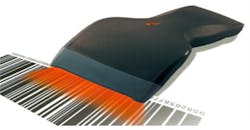Imaging vs. Laser: The Truth About Bar Code Readers
Despite all the focus on RFID as the new cure-all for supply chain ills, there seem to be a stubborn few (well, the majority of companies, actually) who still rely on reading bar codes. But news about advances in bar code reading somehow doesn't make it to the top of the list in new product announcements or product comparison charts. Face it, bar codes are reliable enough to be, well, dull.
The major question these days seems to be relative costs and merits of imagers versus lasers for hand-held reading. And recent improvements to both technologies have increased performance and reduced costs.
Two misconceptions are that a) being cameras, imagers are more fragile, and b) having no moving parts, imagers are more rugged. Both and neither are true. Differences between individual readers are just that—differences between products, not technologies.
When people think of imagers, they immediately assume 2D. But that's no more true than assuming all lasers are simple moving beam, single line readers. There are more options than that.
Imagers come in two configurations, linear and area array. Laser scanners come in three basic configurations, moving beam (single line), rastering (lines that cover an area), and omni-directional (pattern).
So, what are the similarities and differences? In general, laser scanners offer better performance at reading distances over 2 feet and in low light situations. That's the current status. By the end of this year, however, the differences in performance based on ambient lighting may be eliminated. The most significant difference is that only 2D imagers are capable of reading matrix symbols. Beyond that, the decision is more based on product configuration and certain ergonomic considerations.
Single line readers, whether imagers or lasers, are most suited for linear bar code symbols although they can be used for stacked 2D and composite symbols. The differences between linear imagers and laser scanners are that linear array imagers can read at near contact up to about two feet away. Lasers are better for several inches to many feet (depending on model). In this category, imagers are less expensive than laser scanners.
For reading stacked and composite bar code symbols, rastering lasers and 2D imagers both provide an "area" view to speed data capture. Since stacked bar codes such as PDF 417 are designed with tolerance for skew during reading, laser scanners don't necessarily have to be aligned perfectly to get a successful read. 2D imagers, of course, are inherently omni-directional and may therefore be better in applications where operators have to read hard-to-reach symbols and can't orient the reader carefully or where orienting the object (or symbol) for reading would be time consuming.
Omnidirectional laser scanners produce a pattern of scan line to locate and then scan the symbol. These tend to be the priciest lasers and may be more expensive than 2D imagers. "Fly by" scanning (moving a symbol under the reader) with some omni-directional scanners may be somewhat slower than with 2D imagers but some of the "snappiness" of the read also depends on the triggering mechanism.
The price differential between 2D imagers and rastering or omni-directional lasers is as much dependent on your relationship with the vendor and quantities purchased as on anything else.
Because both imagers and lasers will do the job for you, one final consideration—and possibly the deciding one—is the form factor and use options available, whether fixed and hand-held option, integrated in a PDA or similar device, or wrist or ring configuration. Usability should always rank high on any evaluation criteria.
Bert Moore is a 20-year veteran of the AIDC industry. He is director of IDAT Consulting & Education, Alpharetta, Ga.
Recent improvements to both technologies have increased performance and reduced costs.
